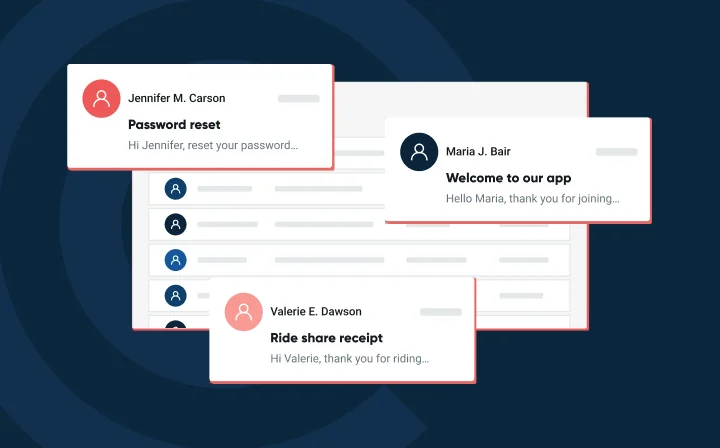How to optimize your email strategy for 2025: Webinar recap


Email is the digital cornerstone of communications between brands and consumers. Yet in 2025, ensuring emails reach the inbox – not just get sent – is more challenging than ever. Evolving mailbox provider rules and growing user expectations make deliverability complicated but we’re here to break it down with statistics and insights from our 2025 state of email deliverability report.
In a recent Mailgun webinar, deliverability experts Nick Schafer (Senior Manager of Deliverability & Compliance) and Kate Nowrouzi (VP of Deliverability) discussed key strategies for optimizing email programs. Here are the key takeaways from their session, including insights on delivery versus deliverability, common spam triggers, email authentication, and performance monitoring.
For many senders, the terms “delivery” and “deliverability” seem interchangeable, but understanding their very different meanings is the trick to improving email success. Delivery refers to whether a message is accepted by the receiving mail server, while deliverability measures where that message lands in the inbox.
What is email delivery?
What is email deliverability?
If you’re confused about the difference between delivery and deliverability and why you need to know what sets them apart, you’re not alone. Only about 12% of those surveyed correctly identified the delivery rate as the percentage of emails sent that are accepted to any folder (including the junk folder).
Sometimes senders forget about deliverability, which is the first piece. When the message is delivered it’s handed off to the recipient server to be placed in the inbox. That’s where deliverability comes into play.
To measure deliverability accurately, track user engagement metrics like opens, clicks, and website visits.
Avoiding the spam folder is one of the most common challenges senders face, but to overcome it, you need to understand why messages end up there. From list hygiene to sender reputation, mailbox providers look at several factors when filtering emails.
Always use confirmed opt-ins and clean your list regularly to minimize risks from spam traps and invalid emails. Learn about double opt-ins and more in our list management best practices post.
Here’s a bonus tip from our experts. The best way to stay out of spam is to know your audience. Not all users are the same, and they don’t need to be treated the same. Use your data and leverage it with personalization and segmentation for better engagement.
Email authentication is the big cheese, the number one way to be sure your messages are trusted by mailbox providers. It verifies that your messages are legitimate and not spoofed, which helps protect both your brand and recipients from phishing attacks. In 2025, authentication will be critical for inbox placement, especially with new requirements from Gmail and Yahoo.
DMARC is an email authentication protocol designed to give email domain owners the ability to protect their domain from unauthorized use, commonly known as email spoofing. It works by works by using DNS records to specify how an email from a domain should be handled if it fails authentication checks through SPF and DKIM.
DMARC was a big topic in email this year and for good reason. While the new sender requirements currently only mandate a DMARC policy of p=none (which is a monitor only policy), that will likely change. And it should.
The p=reject policy is the most effective policy. You’re telling the ISPs ‘if I fail authentication reject my traffic’. If you are a financial organization and that scam email lands in the spam folder, someone might click and become a victim of a phishing attack.

Aside from protecting senders and recipients, Implementing and enforcing DMARC can enhance your credibility and improve inbox placement.
A secure sending program is the foundation of good delivery and deliverability. By safeguarding your sending infrastructure and maintaining compliance with ISP guidelines, you can prevent unauthorized access and cyber threats. Strong security practices reduce the risk of spam complaints and maintain your reputation.
Email success is a continuous process that involves tracking data, interpreting feedback from mailbox providers, and making improvements based on performance insights. By regularly analyzing metrics, you can catch and fix issues before they affect your reputation or deliverability.
Delivery refers to whether an email is accepted by the recipient’s mail server. However, this doesn’t guarantee that the email reaches the inbox. Deliverability focuses on where the email lands (inbox vs. spam) and whether users engage with it.
Avoid common spam triggers by maintaining good list hygiene, minimizing complaints, and following email best practices. Ensure your content is relevant and your list is free from spam traps or inactive addresses.
Authentication protocols like SPF, DKIM, and DMARC verify your sender identity, preventing phishing and ensuring that mailbox providers trust your emails. Without proper authentication, your messages may be flagged as spam or blocked altogether.
Use double opt-in for subscribers, provide easy unsubscribe options, enable two-factor authentication (2FA), and perform regular audits of your sending accounts. Separating transactional and marketing emails on different subdomains or IPs can also prevent issues from affecting all your mail streams.
Regularly monitor engagement metrics like opens, clicks, and spam complaints. Use tools like Google Postmaster and Microsoft SNDS to track your sender reputation. This will set you apart already, we reported that 70% of senders who took our survey aren’t using these tools.